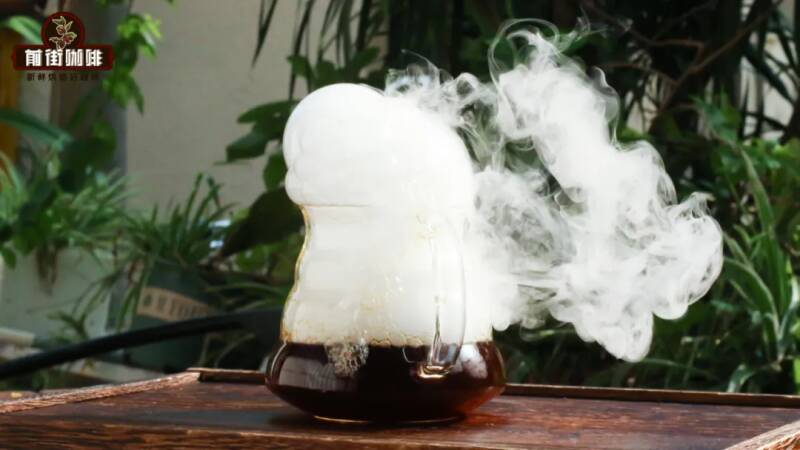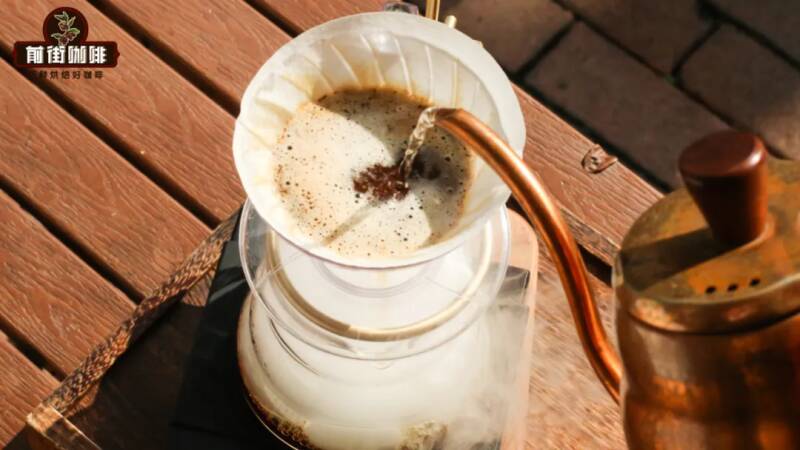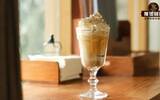Can dry ice be used to make hand-brewed coffee? Can ice cubes used for making coffee be replaced with dry ice?
In the tweet comment area (portal) shared two months ago on Qianjie, many friends left messages proposing to use dry ice instead of ice cubes to make ice hand-made ice. The reason for this is to experience the complete flavor of coffee in the ice hockey.
"If you want to taste the most complete coffee flavor in your hand-brewed coffee, it is best to choose hot hand-brewed coffee. "This is a piece of advice that Qianjie will definitely give whenever a customer asks whether a certain bean in Qianjie is suitable for ice flushing or hot flushing. The reason is simple: hot hand flushing will use more water and the extraction will be more adequate. Ice Hand Chong wants to cool down coffee quickly in a short period of time, so ice cubes need to be added to achieve this goal. However, the melting of ice cubes will dilute the concentration of coffee. If we don't want to drink a cup of coffee with weak taste and thin taste, we need to get a cup of high concentration through a "high-concentration and low-extract" approach. Coffee to offset the dilution caused by melting ice cubes.
The reduction of the amount of water will reduce the extraction efficiency, and the amount of dissolved substances will be reduced, making the coffee flavor relatively less complete. So at the beginning, some friends asked if they could use stainless steel ice cubes that would not melt instead of ice cubes to make ice slacks. The result was obvious and they ended in failure. For various reasons (please refer to that article for details), stainless steel ice cubes could not reduce the coffee to the ideal temperature in a short period of time. So at this time, many friends left a message in the comment area and suggested using "dry ice" that cools quickly and will not cause dilution to be used for hand-brewed ice making.
To make sense, although dry ice can indeed give coffee a quick cooling effect without causing dilution. But! Yes! It is also not suitable for making hand-brewed coffee, especially for store products.
What is dry ice? Conventional ice is a solid formed by condensation of water at low temperatures, that is, ice is the solid state of water. After absorbing heat, it will be reduced to water. Dry ice is completely different! Although it also carries an "ice" in its name, it is vastly different from the ice cubes we use every day. (The small head on the left is dry ice)
Dry ice is a solid made from carbon dioxide. In layman terms, it is solid carbon dioxide. Qian Jie believes that everyone can no longer be familiar with carbon dioxide what is already familiar with, because the gas we breathe out during our breath is carbon dioxide. Carbon dioxide has no liquid form at standard atmospheric pressure (it can form a liquid state under certain high pressure conditions), but it will condense directly into a solid state when the temperature is below minus 78.5℃. When the temperature is higher than minus 78.5°C, solid carbon dioxide will directly sublimate into a gaseous state. Because the solidified carbon dioxide looks very different from conventional ice cubes, and the carbon dioxide changes phase across the liquid stage during the process, and has no liquid form, that is, it will not melt into water when heated, people simply and clearly Name it: "dry ice." (Note: In addition to low temperature, dry ice for daily use also needs to be produced under high pressure)
In fact, in daily life, dry ice is a common item, because the uses of dry ice can be said to be very extensive. Qianjie mentioned earlier that dry ice will directly sublimate into a gaseous state, and during its sublimation, it will absorb a large amount of heat around it. This causes water vapor in the air to liquefy into water droplets due to the drop in temperature, and then form smoke. Many performances such as concerts, stage plays, and even some restaurants and bars use a large amount of dry ice to create beautiful smoke effects. In addition, since the sublimation process of dry ice absorbs a large amount of heat and reduces the temperature of the surrounding environment, dry ice can reduce the temperature of food through direct or indirect contact, achieving effects such as preservation and cooling. At the same time, because it will not liquefy, there is no need to worry about whether the food will be damaged or the concentration will be diluted.

After reading so much, Qianjie believes that everyone has fully understood the structure and function of dry ice. It can indeed allow coffee to cool down quickly without diluting the concentration of coffee. So, the question arises: Why does Qianjie say that it is not suitable for making hand-brewed coffee?

Very simple, because it releases carbon dioxide after sublimation! When we throw dry ice into coffee, although the coffee will cool down quickly, because the dissolved carbon dioxide will combine with the coffee, what we end up getting is not a cup of cold hand-brewed coffee, but a cup of cold carbonated coffee. Even if the purpose of cooling down is achieved, the nature of coffee has changed and far deviates from our needs, so dry ice naturally cannot be used by us.
Maybe some friends will suggest at this time: "Wouldn't it be better to cool down while cooling down? "That's true, but it will be very cumbersome and less efficient. Qianjie believes that there is no need to carry out such complex behaviors specifically to supplement this small part of the flavor. The key is that this kind of work can be done with regular ice cubes, and there is no need to use dry ice at all.
So, don't worry, make your hand-brewed coffee with regular ice cubes. But if you really want to try using dry ice instead of ice cubes to make coffee, you can refer to these three points shared by Qianjie: ①: The ratio of coffee liquor to ice cubes is 2:1, that is, 200ml coffee liquor is mixed with about 100g of ice cubes, so that the temperature can be cooled quickly. (The suggestions here refer to freshly brewed coffee liquor at 70°C.) ②: Not all coffee will taste good when it is made into a "carbonated version", such as those with excessive acidity or bitterness. So we can use coffee beans with high sweetness to make it! For example, the Qianjie Rose Summer Combination·Strawberry Candy, or the Qianjie Esther·Huaquui in the Qianjie Bean List are all relatively sweet ~③: Be sure to pay attention to various uses of dry ice! Dry ice is still relatively dangerous, in all aspects. So be sure to preview the precautions for dry ice before using it to prevent accidental injury by dry ice.④: Don't pour too much dry ice at one time, or prepare a tall bottle to make coffee. Otherwise... How miserable and miserable it must be...
- END -
Important Notice :
前街咖啡 FrontStreet Coffee has moved to new addredd:
FrontStreet Coffee Address: 315,Donghua East Road,GuangZhou
Tel:020 38364473
- Prev

How to make Vienna coffee? Who invented latte coffee? Who is the founder of Blue Bottle House?
In the world of coffee, the dairy product "cream" can be said to be quite common. Because the taste of cream is very rich, it not only has a silky and thick taste, but also has a rich and soft sweet aroma. Therefore, it is often added to various freshly made coffee drinks to take on the responsibility of reconciling bitterness, embellishing products, and increasing the taste.
- Next

Hand-brewed coffee and water injection technique! Tips and methods for injecting water into drip coffee! How to add water to coffee?
Qianjie stores often welcome some friends who teach themselves to make coffee by hand at home to discuss issues related to brewing with Qianjie. Many friends said that although the parameters they use are exactly the same as Qianjie recommends at the store, the coffee brewed tastes always good and bad, and I don't know where the problem is. like this situation
Related
- What ratio of water temperature and ground does the smart cup method use to press coffee? The difference between brewed coffee and filtered coffee?
- What is the standard process for the purpose of coffee cup testing? What is the difference between hand-brewed coffee and cup testing?
- How to use hand-brewed coffee paragon small golden balls? How does cold coffee lock in the aroma of coffee?
- Is American coffee black? What is the difference between American coffee and drip coffee?
- Unexpected! Well-known tea beverage brand Lele Tea will withdraw from the Zhengzhou market!
- Starbucks enters the fashion and beauty industry?! Netizen: Give me an ice American eye cream
- Why can American refills for free? The difference between Americano and American drip pot coffee
- Being chased out of the rain in front of Starbucks?! Store: Sheltering from rain under umbrellas poses a safety hazard
- The white moonlight has changed?! Lucky launches "Big Winter Pear American"
- Hand-brewed coffee three-stage method, high-sweet and universal brewing method to share! What does the high sweet water level of hand-brewed coffee mean?

